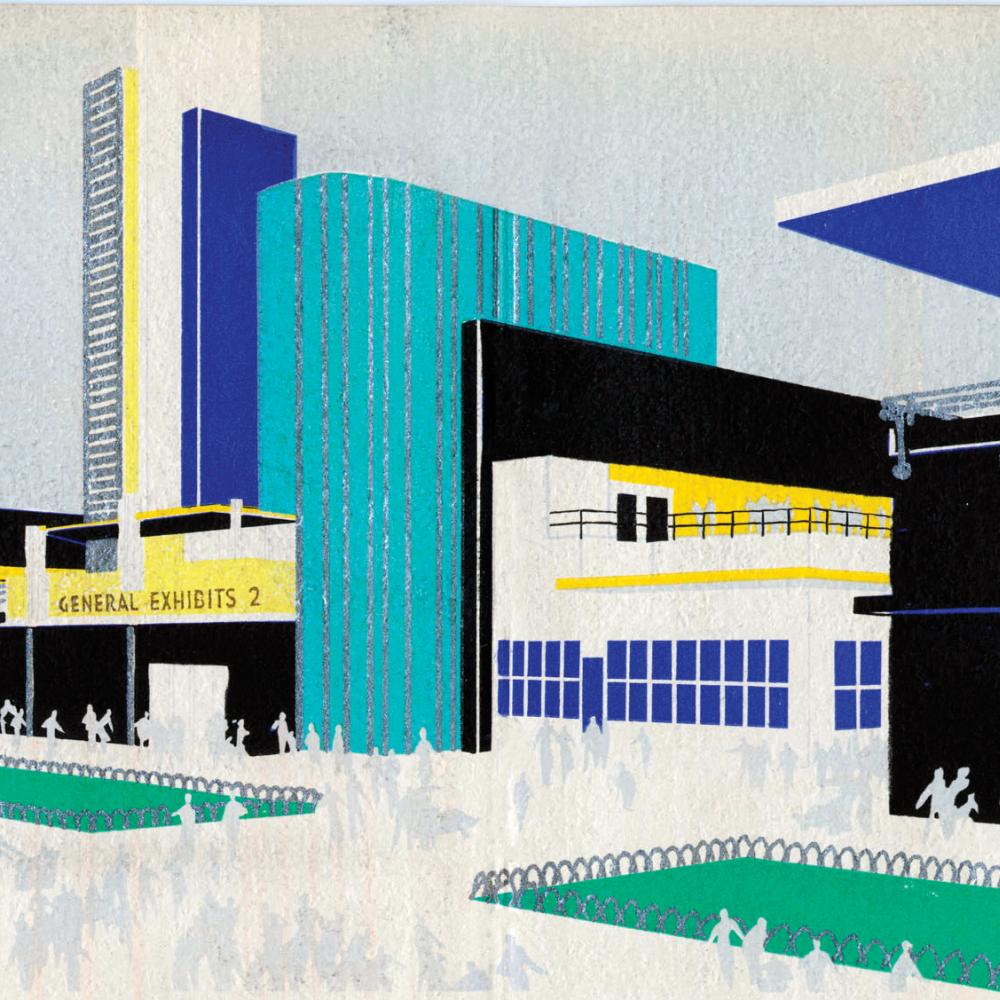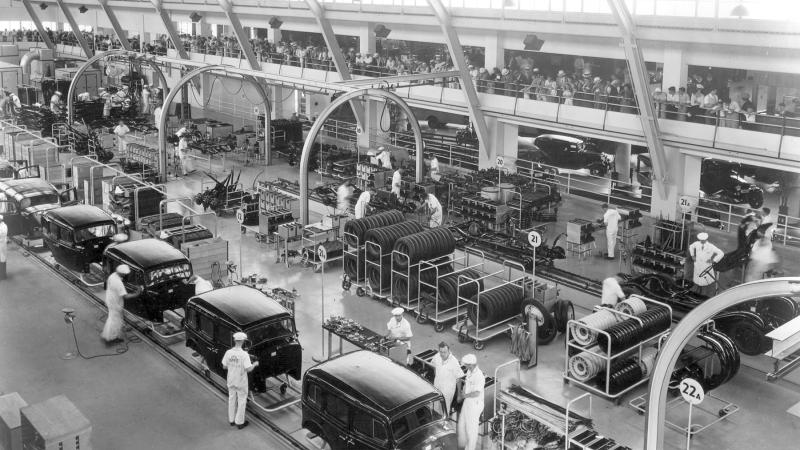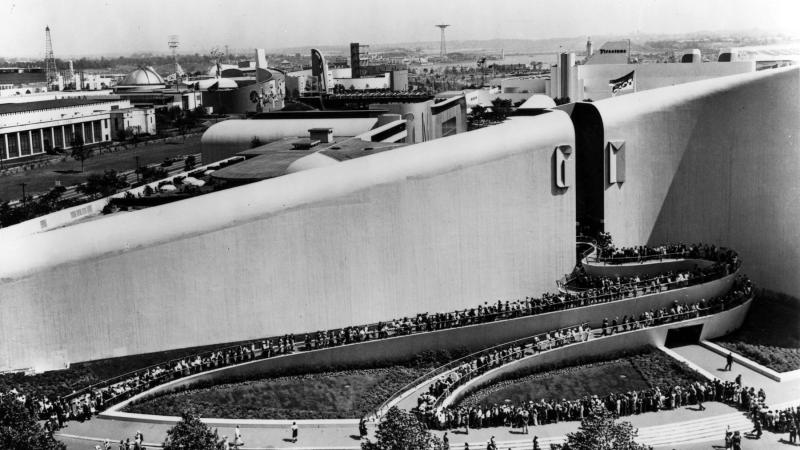Every day, during the first six-month run of the 1939 New York World’s Fair, lines of well-dressed men, women and children formed on the ramps outside the sleek General Motors pavilion. And then, during the fair’s second season in 1940, it was déjà vu: long lines, morning to night.
The pavilion’s popularity was pretty much a given: Who wouldn’t wait patiently to get a spectacular view of the “world of tomorrow”? With the up-to-date good looks of a vastly oversized, stuccoed, streamlined locomotive, the GM pavilion housed one of the fair’s more irresistible and emblematic attractions: a sixteen-minute conveyor-belt ride in a comfortable “sound chair” that enabled a visitor to listen to a newsreel-like commentary while peering down at an impressive, thirty-five-thousand-square-foot, three-dimensional model called Futurama.
Designed by Norman Bel Geddes to whet appetites for a not-too-distant future—the target date was 1960—Futurama earned its renown for its amazing detail. Some fifty thousand tiny automobiles, buses, and trucks scurried about the wide, ribbon-like highways that crisscrossed its convincing terrain of mountains, rolling hills, and lush valleys. Approximately five-hundred thousand buildings, ranging from skyscrapers to single-family homes, enlivened its harmonious, interconnected environment of farms, factories, towns, suburbs, and cities.
Futurama’s future was no fantasy land. Rather, it was a confident extrapolation of existing and new technologies, and a comforting demonstration of the known capacities of American industry. In its ambition and optimism, the huge display was characteristic not only of the New York extravaganza, but also of the unprecedented spate of world’s fairs that had come before in American cities from north to south and coast to coast. This unusual concatenation of world’s fairs in a single country in the same decade had begun in 1933 with the Century of Progress International Exposition in Chicago, and continued through the rest of the 1930s almost without a break in San Diego, Dallas, Cleveland, San Francisco, and New York.
A conservative estimate of the total number of visitors to these fairs would be somewhere above 100 million, and this large in-person experience was, of course, multiplied many times over in countless conversations, newspaper and magazine accounts, radio broadcasts, books, pamphlets, and souvenirs. (Televisions sets, looking for all the world like radio consoles with an odd, oblong window instead of a conventional dial, were introduced in New York, but it would take a decade—and a world war—before this particular technology reached homes in appreciable numbers.)
Despite this extraordinary exposure, awareness of the shine and substance of these enormous expositions—or even knowledge of their collective existence—has faded dramatically over time. “Designing Tomorrow: America’s World’s Fairs of the 1930s,” an exhibition continuing through July 10 at the National Building Museum in Washington, D.C., brings the fairs back into our consciousness. There is a good hardcover book, too, published by Yale University Press and bearing the same title, though it’s not precisely an exhibition catalog. Rather, it contains the research and ruminations of scholars who have been reexamining these almost forgotten events.
At first, the entire episode seems improbable. After all, the wildly optimistic gist of these six fairs stood in sharp contrast to the economic paralysis of the time, and its painful effects: widespread joblessness, dispossession, hunger, and despair. Were the fairs just cynical, escapist fantasies foisted on a troubled populace? The question draws a big fat negative from world’s fair scholar Robert W. Rydell, who writes that, by design, the fairs “helped Americans find their way out of the Great Depression.” The federal government was an active, enthusiastic collaborator in the fairs; President Franklin D. Roosevelt and First Lady Eleanor Roosevelt acted almost as cheerleaders in chief. But the main actors were the businessmen, bankers, and industrialists on the fairs’ committees. Driven by the awful conditions, and perhaps also by fears of social upheaval, they conceived of the vast expositions as uplifting demonstrations of the bountiful prospects of American capitalism—and, above all, its ability to bounce back.
Speaking of the Chicago fair, Harvey S. Firestone (of the Firestone-tire Firestones) characterized it as “a great opportunity for private enterprise to show its achievements to millions of people.” More sonorously, that fair’s official brochure claimed it to be “a magic window out upon a beautifully lighted space of enchanting reality.” If this “reality” was beyond the reach of most Americans at the time, well, that was part of the point. In hundreds of fair pavilions and thousands of exhibits, a time of material abundance and personal happiness—the two were constantly paired—was made to seem attainable and oh so close.
That world’s fairs had the capacity to change cultural norms and set long-lasting trends was proven emphatically in the United States by Chicago’s triumphantly successful 1893 World’s Columbian Exposition—aptly nicknamed “the White City” for its forest of be-columned, be-domed, plaster-coated buildings in the monumental classical mode. The great American architect Louis Sullivan acidly complained that this example would “set American architectural development back fifty years,” and he was right, at least about the duration of the fair’s impact. For better and for worse, the grand exposition ushered in an era of “City Beautiful” civic building that continued even through the 1930s with the ongoing construction of the august Federal Triangle complex in Washington, D.C.
Chicago wanted none of that for its new fair, nor did any of the cities that followed. But if columns, cornices, and the like were to be ruled out, what exactly should replace them turned out to be a question with many answers. Everybody wanted something new and “modern,” but, with the notable exception of Frank Lloyd Wright and a few others, there wasn’t much of a homegrown modern movement to draw upon. And, of that small company, only Albert Kahn, the architect of many an excellent, functionalist factory, was destined to play a significant role in the fairs. (The small-minded exclusion of Wright by his fellow Chicagoans seems especially poignant. He was a difficult man, to be sure, yet as an architect he was a giant approaching his incomparable second prime.)
Consequently, architectural styles at the fairs veered from here to there, and most of the stopping places could lay at least some claim to being modern. Pared-down classicism (usually called “stripped”) was very nearly a worldwide official style of the 1930s—New Deal architects used it, and so did Hitler’s Albert Speer—so, of course, it made its share of fair appearances. The style’s motto could well have been, “Don’t throw out the baby (the classical tradition) with the bathwater (all those distracting classical details).”
In Texas and California, designers attempted to brand a sort of regional modernism, to varying effect. Time delightedly spoofed the official, movie-set Pacifica style of the 1939 Golden Gate International Exposition in San Francisco as “an exotic chow-chow of the ageless East and the American West.” On the other hand, in his wood-and-glass Yerba Buena Club building at the same fair, California architect William Wurster skillfully demonstrated how the regional and the modern could make a complementary pair.
Pop architecture, anticipating the appearance of Pop Art by thirty years, was a smashing hit—it’s hard to imagine not being amused and enticed by a Shell Oil pavilion with a facade in the shape of an elegant shell, or a Wonder Bakery pavilion with a curving white wall enlivened by the peppy red, yellow, and blue dots of Wonder Bread’s familiar packaging. A scattering of buildings at the fairs were sufficiently white, abstract, and rectilinear to be considered part of the International Style, that purist version of high modernism introduced to the United States in an exhibition organized in 1932 by the Museum of Modern Art. But, with the principal exception of the cluster of modern, full-scale model homes in Chicago, they tended to be overshadowed in the general stylistic hoopla.
Streamlining is the style we most often associate with the architecture of the 1930s, and there was a whole lot of it at these fairs. For one thing, with its aerodynamic emphasis on curved lines and horizontal surfaces, streamlining was ideally suited to dress up fair pavilions, which, in terms of basic function, often did not need to be anything more than big, windowless boxes for exhibits and crowds of people. With its speedy lines, streamlining was the perfect style to represent events conveying an ambience of progress—of liveliness, modernity, and forward movement. This dynamic scenario was reinforced all along the line: in the plotting and landscaping of the fairgrounds; in the spectacular night lighting (indeed, to judge simply from photographs, much of the architecture looked better at night); in the color coding not only of banners, signs, and the like but also of the individual buildings and the fairs as a whole. After a visit to the Chicago fairgrounds just before the opening, architect Raymond Hood wrote to designer Joseph Urban, “It was marvelous—swipes of color 40 feet high and 400 feet long . . . [y]our color . . . is going to save the show.”
Urban was trained as an architect but, like many of the industrial designers who came into their own during the years of the fairs, he had a rich, varied professional background. Urban’s specialty had been designing theater sets; others had begun in advertising, illustration, and retail design. It’s not a huge stretch to say that Urban and the others—most notably Bel Geddes, Henry Dreyfuss, Lurelle Van Arsdale Guild, Raymond Loewy, Gilbert Rohde, and Walter Dorwin Teague—came into their primes because of fairs. Most emphatically, these designers played major roles, bringing a sense of the whole of modern design that eluded many architects at the time. In a very real sense, they brought European modernism to the United States and, in the process, adapted it to America’s commercial realities. Teague, for example, preached a theme that originated at Bauhaus, the pacesetting German design academy. Modern design, he said, ought to animate “buildings, furniture, clothing, textiles, even common utilities of everyday life.”
For this extraordinarily talented group, the fairs were fields of opportunity. In Bauhaus spirit, they designed just about everything from important buildings (such as Teague’s Ford pavilion in Southern California, now the San Diego Air & Space Museum), to major exhibits (such as Dreyfuss’s “Democracity” in New York). A short but representative list of consumer products they introduced at the fairs includes, for instance, the Electrolux vacuum cleaner (Guild), the Standard Gas enamel-coated stove (Bel Geddes), the Sears Coldspot refrigerator (Loewy), the Kodak Bantam Special camera (Teague), and the Western Electric Model 302 desk telephone (Dreyfuss).
These and thousands of other items were for sale, of course—world’s fairs were always about selling things. Consider, for instance, the title of the 1851 fair in London, the first major world’s fair of the industrial era: Great Exhibition of the Works of Industry of All Nations. But world’s fairs are about ideas, too. Underlying that seemingly straightforward London title, for instance, is an intricate set of ideas and values concerning competition, innovation, social organization, productive processes. Each of the six American world’s fairs of the 1930s was a complex event in and of itself, but to a remarkable extent these fairs shared a certain concept of the future, an optimistic message based on faith in the capitalist system and centered, also remarkably, on two principal material possessions: the single-family home and the private car.
Each of the fairs had an extensive section on home ownership accompanied by full-scale or scale-model homes of the future (which not infrequently looked, on the outside at least, a lot like homes of the past). And each had acres and acres of buildings and exhibitions devoted to automobiles—their design, performance, purchase, and care—and the roads needed to accommodate them. Not incidentally, the vast majority of consumer goods on display had to do with one or the other. Often, exhibits imaginatively combined the two, as in architect George Fred Keck’s House of Tomorrow at the Chicago fair—a twelve-sided affair with floor-to-ceiling glass walls, modern furnishings and fixtures in every room, and a built-in garage for the family car (and also the family airplane!).
At the beginning of the Building Museum exhibition, a big statement is made about the fairs. “Their tomorrows look much like our today,” the caption says. This is a large claim, indeed, and it’s also true—but only up to a point. After all, the United States has changed a lot in the seventy years since the last of these fairs closed its gates—mom, for instance, is not necessarily stuck in the kitchen happily taking care of her 2.3 children while dad commutes to the office. And although many Americans have been able to enjoy the benefits of the futures the fairs laid before them like so many tempting fruits, they’ve also experienced some of the costly spoilage—the sprawl, the pollution, the traffic. It’s clear, in short, that the old fairs’ futures need a bit, or even a lot, of work. Today, it probably would be more accurate—certainly more optimistic—to conclude that “Their tomorrows are our yesterdays.”




